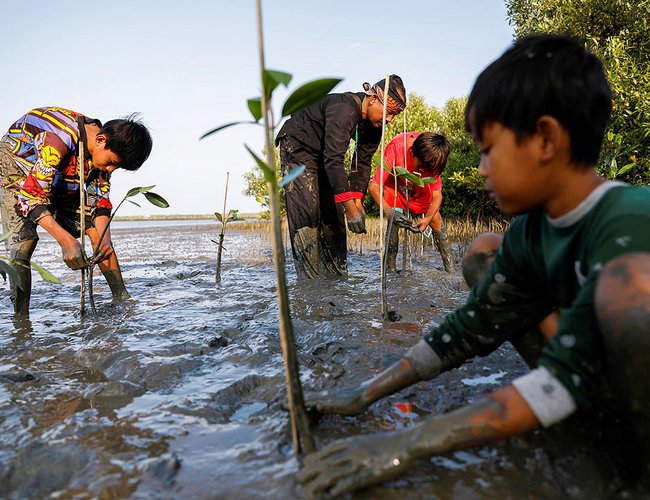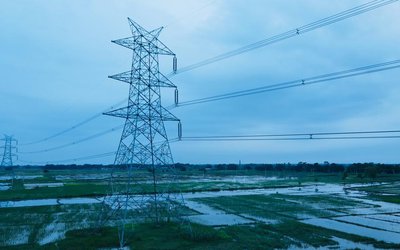
- Landscape of disaster and climate risks in the Pacific region
The Pacific region is an epicenter of extreme weather events. Countriesare isolated by vast expanses of ocean, making them particularly susceptible to climate-induced disasters, both rapid-onset events such as cyclones and floodsas well as slow-onset events like droughts. The seismicity near the intersection of the Australian and Pacific tectonic plates increases the risk of tsunamis to low-lying island communities and coastal areas as well as volcanoes and earthquakes, but the majority of disaster events in the Pacific are the consequence of climatic variability. A detailed analysis of disaster data from the past decade reveals an alarming increase in both the frequency and intensity of disaster events.Among recent disasters isPapua New Guinea's catastrophic rainfall-induced landslide in May 2024; Lola, thecyclone that struck Vanuatu and the Solomon Islands in October 2023;Judy and Kevin, thecyclones thatmade landfall in Vanuatu in March 2023;Harold, thecyclone that hitthe Solomon Islands, Vanuatu, Fiji, and Tonga in April 2020;Ana, thecyclone that hit Fiji in January 2021;and Yasa, thecyclone that impacted Fiji in December 2020. Flash floods have also been significant, affecting Fiji and Samoa in 2023 and Tuvalu, Kiribati, and the Solomon Islands in 2020. These disasters disrupted the lives and livelihoods of resource-poor people and communities.
1 Impacts of disaster and climate risks
The impacts of disaster events are multi-faceted and complex, especially as one disaster event can cause multiple disasters. Tropical cyclones such as Winston in Fiji (Feb-March 2016) and Pam in Vanuatu (March 2015) cause destructive winds, heavy rainfall, and storm surges. These storm surges, exacerbated by rising sea levels, lead to coastal flooding and erosion. Prolonged droughts, like those in Papua New Guinea and Fiji, and landslides, like the recent ones in Papua New Guinea (May 2024),affect water availability: having an impact on agriculture, and hydroelectric power generation, just to name a few. Intense rainfall causes flash floods and landslides, as seen in the Solomon Islands during the 2012 event.Specific characteristics of some Pacific countries also propagate the impacts of disasters. For instance, several Pacific Island nations, including Vanuatu, the Solomon Islands, and Kiribati, are highly vulnerable to disaster events due to their geographical location, low-lying terrain, and reliance on agriculture and fisheries. Both Vanuatu and the Solomon Islands face significant risks from tropical cyclones and storms, a fact made worse by their low elevations and limited infrastructure and resources. Kiribati, comprising low-lying atolls, is highly susceptible to the sea-level rise and consequent increase in storm surges, especially as its economy is heavily dependent on fisheries and agriculture.
Disasters have multiplier effects: they have significant adverse impacts onthe environment, societies, and economies. The environmental impacts of cyclones and floodsinclude soil erosion, deforestation, the destruction of natural habitats, and freshwater contamination, while earthquakes and volcanic eruptions alter landscapes, destroy ecosystems, and release harmful gases and ash into the atmosphere. Droughts exacerbate water scarcity, stress agricultural systems, and increase the risk of wildfires. In addition, coral bleaching and oil spills degrade marine ecosystems, threatening biodiversity and the livelihoods dependent on it. Suchenvironmental disruption not only affects the immediate health of ecosystems but also undermines long-term ecological balance and sustainability, complicating recovery, adaptation, and mitigation efforts.
The social impacts of disasters are profound and far-reaching. They displace populations, disrupt livelihoods, and exacerbate poverty, particularly among the most vulnerable. Unfortunately, oftentimes, disasters tend to increase the number of vulnerable groups putting more strain on the already small and ill-equipped small island states. These consequences in turn lead to the loss of lives and livelihood, food insecurity, and diminished access to clean water and healthcare. The damage extends to areas such as education which is severely affected since schools areeither damaged or used shelters causing interruption to children's learning. The psychological tollon society; primarily stress, anxiety, and traumais significant. In addition, the breakdown of social networks and community structures, hampers recovery efforts and long-term development, further entrenching social inequalities.
On the economic front, disasters damage infrastructure, impacting homes, roads, bridges, and public facilities, and cause agricultural losses, affecting crops, livestock, and fisheries. These impacts decreaseoverall growth. For example, the Judy and Kevin cyclones lead Vanuatu to revise its GDP growth forecast for 2023 from 3.6% to 3.0%. Though the economic and infrastructural damage caused by disaster events in the Pacific region is substantial, specific figures vary widely depending on the event and the affected area. For example, the landslide in Papua New Guinea's Enga Province in 2024 resulted inheavy losses. Flash floods have caused millions of dollars in damage in recent years. The 2022-2023 droughts in Kiribati and Tuvalu led to immense economic losses, particularly in terms of water supply and agricultural productivity. The 2022 Tonga volcanic eruption and subsequent tsunami caused extensive damage, with early estimates suggesting losses in the hundreds of millions of dollars. Cyclone Harold in 2020 resulted in around $123 million in damage in Vanuatu andaffectedover 160,000 people. Cyclone Winston in 2016 cost Fiji about $1.4 billion, or one-third of the country's GDP thatyear. Cyclone Pam in 2015 cost Vanuatu around $450 million, or roughly 64% of its GDP.
2 Current initiatives in policies and practicesand emerging challenges
Pacific countries have developed various disaster risk reduction (DRR) and climate change adaptation (CCA) policies to mitigate the impacts of disasterand climate change. These focus on preparedness, response, recovery, and resilience. For example, Fiji's National Disaster Risk Reduction Policy (2018-2030) integrates DRR into national development planning, enhancing community resilience through sustainable development, climate adaptation, and legislative frameworks.Vanuatu's National Disaster Management Plan (2005) emphasizes early warning systems (EWSs), community awareness, and capacity-building andoutlines theroles and responsibilities of government agencies for effective risk assessment and resource allocation during emergencies. Samoa's National Action Plan for Disaster Risk Management (2017-2021) aims to boost national capacity for disaster preparedness and response through risk mapping, public education, and strongEWSs. The Solomon Islands National Disaster Management Plan (2018) offers a comprehensive framework for disaster risk management thatemphasizeslocal capacity-building and public awareness.Papua New Guinea's Disaster Risk Reduction and Climate Change Adaptation Policy (2016) integrates climate adaptation with DRR, focusing on community-based approaches, traditional knowledge, and institutional capacity-building.Tonga's Joint National Action Plan on Climate Change and Disaster Risk Management (developed in 2010 and updated to cover 2018-2028) combines climate adaptation and disaster risk management (DRM) strategies, promoting infrastructure improvements, ecosystem protection, and community-based initiatives. Many countries also developed and operationalized nationally determined contributions (NDCs) and national adaptation plans (NAPs).The Asia Pacific Regional Policy Forum also supported individual countries in developing their policies.
These policies reflect a comprehensive approach to DRR. They integrate DRM with sustainable development and climate adaptation, thereby enhancing the resilience of Pacific countries to disasterevents and reducing their vulnerability to disasters.That said, any, no matter how small apolicy barrier, hinders progress. Many Pacific countries lack adequate financial and human resources as well as inadequate infrastructure, fragmented governance, and insufficient policy coordination. Weak building codes and limited transportation networks exacerbate the impact of disasterevents, while the varied governance capacities ofsmall island nations hinder effective collaboration.Moreover, the struggle to develop and implement effective CCA strategies is evident, primarily due to limited access to data, technical expertise, and financial support. In addition, the limited capacity for implemented EWSs has left many Pacific island nations vulnerable to sudden-onset disasters.
In Fiji, consulted stakeholders at the National Disaster Management Office said that ecosystem-based approaches hadsignificantly reduced disaster risks by leveraging natural systems to enhance resilience and mitigate impacts. They said thatapproaches such as using mangroves, coral reefs, and seagrass bedsas natural barriers against storm surges and coastal erosion had worked well. Watershed management, for its part,helps to slow water flow and reduce flood risks, and reforestation and sustainable land practices help prevent landslides and soil erosion. Agroforestry improves soil health and food security. In Kiribati, stakeholders of the Disaster Management Office emphasized that initiatives like establishing marine-protected areas help preserve marine biodiversity, support fisheries and protect the coast, while community-based resource management engages locals in sustainable practices and enhances their disaster-response capabilities. There are not, however, sufficient human, technical, or financial resources to make all these initiatives a success.
Stakeholders of the Federal Emergency Management Authority in the Federated State of Micronesia said thatCCA practiceshelp to reduce disaster risks. For instance, building climate-resilient infrastructures, such as elevated homes, flood barriers, and cyclone-resistant buildings, enables communities to withstand disasters and minimize damage. Advanced EWSs for cyclones, floods, and tsunamis, they said, ensure that people are warned in time to take precautions and/orevacuate. Tongan stakeholdersof the National Emergency Management Office opined that sustainable land management, including reforestation, soil conservation, and sustainable agriculture, improves land resilience and water quality, mitigating the impacts of droughts and floods. They stated, too,that water resource management strategies, such as rainwater harvesting and improved irrigation systems, help manage water scarcity and flooding. However, since adequate political will and plans and programs are lacking, policies are not adequately implemented on the ground.
3 Potential pathways to reduce the impacts of disaster and climate risks
Pathway 1: Translate comprehensive DRR and climate policies and strategies into action
Mitigating the impacts of disasters demands comprehensive DRR and CCA policies and strategies. DRR involves bolstering EWSs, strengthening community readiness, and ensuring the resilience of infrastructure. EWSs need to bedesigned, implemented, and enhanced to warn against cyclones, floods, and other disasters and improve communication networks to ensure the timely dissemination of warnings to vulnerable communities and last-mile populations.There is a need to conductregular educational activities, review-and-reflection sessions, and training programs as well as drills within communities themselves to enhance disaster preparedness and ensure familiarity with evacuation plans.Efforts are required to construct and retrofit infrastructures to withstand disasterevents. At the same time, a need for building cyclone-resistant housing and fortifying critical public infrastructures such as schools and hospitals.
Strengthening policies and governance frameworks supports coordinated responses to climate risks and will helpPICs reduce their vulnerability to climate-related disasters, safeguard livelihoods, and promote sustainable development amidst changing climatic conditions.Key goals are(i) prioritizing the development and implementation of NDCs and NAPs focusing on climate resilience and DRR, (ii) fostering strong regional cooperation among PICs to share resources and provide mutual support in tackling climate-related challenges, and (iii) securingadditional funding and technical assistance from international organizations to support the implementation of NDCs and NAPs.
Pathway 2: Use CCA practices
It is imperative to adopt an integrated approach focusing on coastal management, water sustainability, and resilient agriculture through CCA strategies. Some needed measures are (i)protecting and restoringnatural barriers such as mangroves, coral reefs, and seagrasses through integrated coastal management approaches, (ii) developingdrought-resistant water supply systems and promotingthe use of efficient irrigation techniques to ensure sustainable water management, and (iii) encouragingthe selection of suitable crops, crop diversification, and adoption ofsustainable farming practices to enhance the resilience of agriculture to climate change.Community-based adaptation engages locals in planning andensures the adoption ofculturally appropriate measures that address vulnerabilities by combining traditional knowledge with scientific approaches.Countries need supportin facing disaster and climate risks throughjoint preparedness efforts and coordination withinternational partners upon the request of national governments. Post-disaster recovery and resilience plans need to be operationalized at the fullest scale to promote social protection systems and enlarge investments in DRR.
Pathway 3: Utilize ecosystem-based approaches
Eco-system-based approaches are instrumental in reducing disaster and climate risks. They emphasize nature-based solutions by (i) implementing strategies such as reforestation, wetland restoration, and sustainable land management to bolster natural resilience, (ii) expanding and efficiently managingmarine-protected areas to safeguard marine biodiversity and support fisheries and enforcing regulations to prevent overfishing and ensure the sustainable management of marine resources.Several good initiatives have already been started in a fragmented manner, but they need stronger policy support to ensure long-term sustainability.
Pathway 4: Prioritize technological and scientific innovation
Prioritizing technological and scientificinnovation is important to strengthen resilience in PICs. It can be achieved by (i) allocating resources to climate and weather research to enhance predictive capabilities, which can, in turn, inform effective policy decisions, (ii) fostering the adoption of renewable energy sources to decrease reliance on fossil fuels and enhance energy security, (iii) designing and building green infrastructure using sustainable materials and practices, and (iv) ensuring information management system to reduce environmental impact and effectively manage the impacts of disaster events.Collaboration among the PICs is essential for sharing technological and scientific innovations to create synergy.
Pathway 5: Learn and replicate otherregions’ good practices and learning
Pacific countries can learn from and replicate good practices from other regions to reduce the impacts of disasterevents. Bangladesh's effective and integrated EWSs for cyclones, which incorporate real-time data collection, forecasting, and community dissemination, can serve as a model. Pacific countries can invest in similar systems to ensure accurate information reaches vulnerable communitiesin time to save lives and productive assets. Community-based DRR programs in the Philippines and Nepal involve local communities in preparedness, response planning, and resilience-building. Pacific nations can engage local communities in disaster preparedness and response training to enhance resilience and ensure a quick, coordinated response during emergencies.Japan's tsunami-resistant buildings and elevated coastal infrastructure demonstrate the importance of resilient infrastructure. Pacific countries can upgrade and retrofit critical infrastructure to withstand multiple disasters.
Costa Rica's ecosystem-based approaches, like reforestation and mangrove restoration, effectively reduce the impacts of disaster. Pacific countries can implement similar nature-based solutionsto provide natural barriers against storm surges and coastal erosion.The innovative urban planning strategies of the Netherlands, including floating homes and adaptive delta management, also offer valuable lessons. Pacific countries can incorporate sustainable urban planning practices, such as building elevated homes and creating green spaces that absorb floodwaters.Israel's advanced irrigation techniques and drought-resistant crops help maintain agricultural productivity in arid conditions. Pacific countries can adopt similar measures.
Germany's investments in renewable energy reduce reliance on fossil fuels and enhance energy security. Pacific nations can invest in renewable energy sources like solar, wind, and geothermal to reduce greenhouse gas emissions and increase energy security.Pacific countries can develop and implement robust NDCs, and NAPs and seek international cooperation and funding to support resilience initiatives.The European Union's comprehensive climate adaptation policies and funding mechanisms support member states in building resilience.By learning from Europeanexamples and adapting these practices to their unique contexts, Pacific island nations can significantly enhance their capacity to manage and mitigate the impacts of different disasters.
Pathway 6: Document learning and manage knowledge through systemic evaluations
Documenting learning and managing knowledge by evaluating DRR programs is crucial for reducing disaster risk. This process involves identifying and sharing best practices, enhancing program designs by understanding strengths and weaknesses, and improving decision-making usingwell-documented evaluations. There is a need to continue systematic evaluation oflearning from past experiences, foster adaptation to changing conditions, promote accountability and transparency, and build trust among stakeholders. Also needed is collaboration on DRR efforts among governments, civil society organizations, the private sector, international development organizations, and academia. In addition, empowering local communities with knowledge strengthens their resilience.

Dr. Dhruba Gautam is an independent evaluator and researcher with expertise in natural resource management, climate resilience, and disaster preparedness across the Asia-Pacific region. He also serves as an Adjunct Fellow at the Humanitarian and Development Research Initiative (HARDI) at Western Sydney University. He can be contacted at drrgautam@gmail.com.

Mr. Kiye Mwakawago is a development practitioner currently serving as Project Manager with the UNDP SURGE Delivery Lab in New York. Before this, he worked as Operation Advisor for the UNDP Multi-Country Office in Fiji. He can be reached at kiye.mwakawago@undp.org.
















